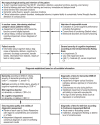The Prevalence of Dementia and Cognitive Impairment in Hospitals
- PMID: 30565543
- PMCID: PMC6318438
- DOI: 10.3238/arztebl.2018.0733
The Prevalence of Dementia and Cognitive Impairment in Hospitals
Abstract
Background: The care of elderly patients with comorbid dementia poses an increasing challenge in the acute inpatient setting, yet there remains a lack of representative studies on the prevalence and distribution of dementia in general hospitals.
Methods: We conducted a cross-sectional study of patients aged 65 and older in randomly selected general hospitals in southern Germany. Patients were excluded if they were in an intensive care unit or isolation unit or if they were on specialized wards for psychiatry, neurology, or geriatric medicine. The findings are derived from patient interviews, neuropsychological testing, standardized rating scales, questioning of nursing staff, and the patients' medical records.
Results: 1469 patients on 172 inpatient wards of 33 hospitals were studied. 40.0% of them (95% confidence interval, [36.2; 43.7]) had at least mild cognitive impairment. The point-prevalence of dementing illnesses was 18.4% [16.3; 20.7]. Delirium, most often on the basis of dementia, was present in 5.1% [3.9; 6.7]. 60.0% had no cognitive impairment. Dementia was more common among patients of very advanced age, those who were dependent on nursing care, those who lived in old-age or nursing homes, and those with a low level of education. Among patients with dementia, only 36.7% had a documented diagnosis of dementia in the medical record. Patients with dementia were treated more often for dehydration, electrolyte disturbances, urinary tract infections, contusions, and bone fractures, as well as for symptoms and findings of an unknown nature, and much less often for cancer or musculoskeletal diseases.
Conclusion: Two out of five elderly patients in general hospitals suffer from a cognitive disturbance. Patients with severe impairments such as dementia or delirium often need special care. Guidelines and model projects offer approaches by which the inpatient care of patients with comorbid dementia can be improved.
Figures







Comment in
-
Prolonging Influence on Length of Stay.Dtsch Arztebl Int. 2019 Feb 15;116(7):116. doi: 10.3238/arztebl.2019.0116a. Dtsch Arztebl Int. 2019. PMID: 30905337 Free PMC article. No abstract available.
Similar articles
-
[Dementia friendly care services in general hospitals : Representative results of the general hospital study (GHoSt)].Z Gerontol Geriatr. 2018 Jul;51(5):509-516. doi: 10.1007/s00391-017-1339-7. Epub 2017 Nov 6. Z Gerontol Geriatr. 2018. PMID: 29110137 German.
-
Exploring the prevalence and variance of cognitive impairment, pain, neuropsychiatric symptoms and ADL dependency among persons living in nursing homes; a cross-sectional study.BMC Geriatr. 2016 Aug 22;16(1):154. doi: 10.1186/s12877-016-0328-9. BMC Geriatr. 2016. PMID: 27549203 Free PMC article.
-
Dying comfortably in very old age with or without dementia in different care settings - a representative "older old" population study.BMC Geriatr. 2017 Oct 5;17(1):222. doi: 10.1186/s12877-017-0605-2. BMC Geriatr. 2017. PMID: 28978301 Free PMC article.
-
Care challenges in older general hospital patients : Impact of cognitive impairment and other patient-related factors.Z Gerontol Geriatr. 2019 Nov;52(Suppl 4):212-221. doi: 10.1007/s00391-019-01628-x. Epub 2019 Oct 18. Z Gerontol Geriatr. 2019. PMID: 31628613 Free PMC article. Review.
-
Considerations and Current Trends in the Management of the Geriatric Patient on a Consultation-Liaison Service.Curr Psychiatry Rep. 2020 Apr 13;22(5):21. doi: 10.1007/s11920-020-01147-2. Curr Psychiatry Rep. 2020. PMID: 32285305 Review.
Cited by
-
"EduKation demenz® Nursing" in the acute hospital setting : Evaluation of a dementia training program: a pilot study.Z Gerontol Geriatr. 2021 Nov;54(7):659-666. doi: 10.1007/s00391-020-01838-8. Epub 2021 Jan 12. Z Gerontol Geriatr. 2021. PMID: 33433665 English.
-
Ethics, design, and implementation criteria of digital assistive technologies for people with dementia from a multiple stakeholder perspective: a qualitative study.BMC Med Ethics. 2024 Jul 27;25(1):84. doi: 10.1186/s12910-024-01080-6. BMC Med Ethics. 2024. PMID: 39068472 Free PMC article.
-
Uncovering the extent of dementia prevalence in Iran: a comprehensive systematic review and meta-analysis.BMC Public Health. 2024 Apr 25;24(1):1168. doi: 10.1186/s12889-024-18415-y. BMC Public Health. 2024. PMID: 38664651 Free PMC article.
-
A pilot observational study to analyze (in)activity and reasons for sedentary behavior of cognitively impaired geriatric acute inpatients.Z Gerontol Geriatr. 2019 Nov;52(Suppl 4):273-281. doi: 10.1007/s00391-019-01644-x. Epub 2019 Oct 29. Z Gerontol Geriatr. 2019. PMID: 31664583 Free PMC article.
-
Structured Delirium Management in the Hospital.Dtsch Arztebl Int. 2022 Mar 18;119(11):188-194. doi: 10.3238/arztebl.m2022.0131. Dtsch Arztebl Int. 2022. PMID: 35197189 Free PMC article.
References
-
- Statistisches Bundesamt (Destatis) Gesundheit, Grunddaten der Krankenhäuser. 2016 Fachserie 12, Reihe 6.1.1, 2017.
-
- Mukadam N, Sampson EL. A systematic review of the prevalence, associations and outcomes of dementia in older general hospital inpatients. Int Psychogeriatr. 2011,;23:344–355. - PubMed
-
- Pinkert C, Holle B. Menschen mit Demenz im Akutkrankenhaus Literaturübersicht zu Prävalenz und Einweisungsgründen. Z Gerontol Geriat. 2012;45:728–734. - PubMed
-
- Dewing J, Dijk S. What is the current state of care for older people with dementia in general hospitals? A literature review. Dementia (London) 2016,;15:106–124. - PubMed
Publication types
MeSH terms
LinkOut - more resources
Full Text Sources
Medical

